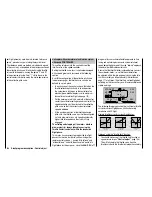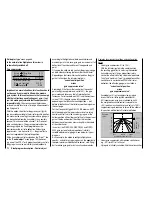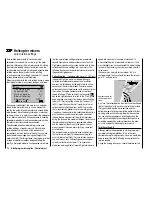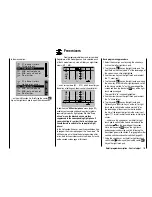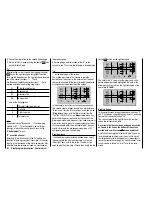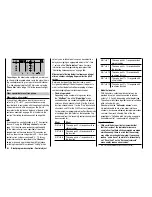
169
Detail program description - Control adjust
control turned fully to the left; the motor will be idling
and respond only to C1 trim. This option permits you
to start and also stop the motor from within any fl ight
phase.
Once the motor has started, turn the throttle limiter
slowly
in the direction of the opposite end-point, so
you can once again activate the throttle servo fully
using the throttle/collective pitch stick. To stop the
throttle limiter limiting the throttle servo at its top end-
point, you should access the "Th.L.12" line on the
"
Control adjust
"
menu and set the control travel to
+125% on the plus side of the "travel" column. Leave
the default value of "GL" in the "Type" column alone,
however, to confi gure this setting globally for all fl ight
phases.
For a more fi nely-tuned control travel curve for the
throttle limit control, you can also use the "Expo
throttle limiter" (page 107). This gives you the option
of defi ning the idle setting at the throttle limit control's
center position, as readily determined both visually
and audibly.
Set the throttle limiter to its center position and adjust
the "EXPO thro lim." value as far as is needed until
the motor is idling smoothly with the proportional
rotary control set at its center point. In this position,
the motor will then start without any problems. To
switch off, you will turn the throttle limit control – thus
without also using C1 switch-off trim – to its rearmost
end-point. As you do, ensure that the affected servo
cannot hit an end-stop mechanically.
The throttle restriction set by the throttle limiter is
made visible as a horizontal bar in the diagram:
0%
0%
0%
C1
Throttle
?
Input
Output
Point
Nor mal
Cur ve
off
The output signal for the throttle servo can never
be higher than that set by the horizontal bar. In this
example, it is thus max. ~50%.
Since electric drive systems have no need for an
•
idle setting, the basic confi guration of settings for
an electrically-powered helicopter merely involves
making sure that the control range of the throttle
limiter is both higher and lower than the adjustment
range of the speed controller (usually -100% to
+100%) by a safe margin. If necessary, therefore,
adjust the "travel" setting of the throttle limiter as
appropriate on the "Th.L.12" line of the "
Control
adjust
" menu. Leave the default value of "GL" in
the "Type" column alone, however, to confi gure this
setting globally for all fl ight phases.
Fine-tuning of the throttle curve itself, however, must
take place in fl ight – as with a glow-powered heli.
If you wish to record the fl ight time of a (glow-
•
powered) heli, you can assign a control switch to the
throttle limit slider, and then use this to switch a timer
on and off; see page 123.
For auto-rotation fl ight, an automatic switch-over
is made from this mixer to a confi gurable default
value; see page 178.
Helicopter with speed GOVERNOR
Unlike speed
controllers
, which merely adjust the
output level – in a way similar to a carburetor – a
speed
governor
keeps the speed of the system it is
controlling constant by regulating the output provided
autonomously. For glow-powered helis, the governor
therefore controls the throttle servo itself as appropriate
– or the speed controller of an electric heli in a
comparable way. Accordingly, speed
governors do not
therefore require a traditional throttle curve but a speed
setting.
A deviation from the preset speed will therefore
only take place if the level of output required exceeds
the maximum level available.
Usually, receiver output 8 is reserved for connecting a
speed
governor
; see the receiver assignments on page
59. If this connection is in use, however, then the throttle
limiter function is unavailable, since this exclusively
affects the then unoccupied output 6, via the mixer
"C1
Throttle".
To still make use of the comfort- and safety-related
features of the throttle limiter, you should ignore the
general connection advice and connect the speed
governor to receiver output 6. You then need only adjust
the throttle curve appropriately, so this can take over the
role of the "usual" transmitter control.
Since in this case the "throttle curve" only regulates the
target speed of the motor controller and this target motor
speed should typically remain constant over the entire
collective pitch adjustment range, the "C1
Throttle"
mixer must be used to set a horizontal line – i.e. every
(pitch) input value will result in the same ("throttle")
output value – whose "height" is defi ned by the target
motor speed.
First, therefore, the reference points "1" to "4" – if
Содержание mx-20 Hott
Страница 1: ...Programming Manual 33124 mx 20 HoTT 1 en H O P P I N G T E L E M E T R Y T R A N S M I S S I O N mx 20...
Страница 41: ...41 Your notes...
Страница 49: ...49 Your notes...
Страница 55: ...55 Your notes...
Страница 81: ...81 Your notes...
Страница 85: ...85 Your notes...
Страница 89: ...89 Your notes...
Страница 99: ...99 Detail program description Control adjust...
Страница 127: ...127 Detail program description Control adjust...
Страница 131: ...131 Detail program description Control adjust...
Страница 163: ...163 Detail program description Control adjust...
Страница 191: ...191 Detail program description Control adjust...
Страница 207: ...207 Detail program description Control adjust...
Страница 228: ...228 Detail program description Control adjust...
Страница 229: ...229 Detail program description Control adjust...
Страница 251: ...251 Detail program description Control adjust...














